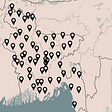SAUDI ARABIA AND RUSSIA: THE OIL WAR AND THE WAY AHEAD
The month of March began with the outbreak of the global turmoil (attributed to Covid-19) which led to tumbling down of the crude oil price to below $25 per barrel. Within a few days, Russia announced its disengagement with the OPEC (popularly called as OPEC Plus agreement) that regulated the supply of crude oil to the rest of the world. This led to, what is referred to by many as the “Oil War” between Russia and Saudi Arabia (an important member country of the OPEC).
The Story Decoded
The story goes back to 2010 when oil price spiked owing to the rising oil demand by China and the geopolitical conflicts in the oil producing economies like Iraq. This incentivized the investors in US and Canada to invest in the shale industry (whose production was otherwise deemed to be expensive and hence not profitable). This led to skyrocketing oil supply which resulted in excessive oil supply. The crude oil plummeted in 2014 from $110 per barrel to half way down at $50 a barrel. OPEC intervened to control the situation by cutting back the production till price stabilized. Russia (a non-OPEC member and of the leader in oil production outside OPEC) later joined this pact which came to be called as OPEC Plus Deal. Since then, The OPEC countries are experiencing a declining market share at the hands of the non-OPEC producers (mostly accounted to the US). As of 2020, Opec provides for merely 33% of the global market while the remaining is served by the non-OPEC counterparts.
Definitely this deal came up with its own costs and benefits for Russia. On one hand, this move led to a recovery in crude oil price and hence the reserves of the National Wealth Fund nearly doubled from $65 billion to $145 billion in 2019.(Al-monitor)
The swing side is in terms of the booming frackers of the US Shale industry. In fact, since 2016, US captured nearly 40% of the market with increasing oil production by about 4 million barrels a day. Russia and Saudi Arabia showcased a fairly stable position in this regard.
However, things weren’t stable for long. In the beginning of 2020, many oil buyers in China called off the trade deals with the oil producers due to the havoc wreaked with the lethal corona virus. The oil market did not take this up strongly and the price plunged. The OPEC-plus meeting was held in the wake of this scenario and two proposals were presented.
One was proposed by Russia to extend the deal by another quarter and utilise the time to evaluate the impact of the crisis on the oil market. The other proposal was put forth by Saudi Arabia which focused on slashing production further by 1.5 billion barrels per day. This required Russia to cut the production by almost 300,000 barrels per day(double of what was currently being pursued under the pact).
The participants of the meeting failed to agree upon any proposal and found in their best interest to take a divorce from the pact. The prioritisation shifted from regulating the price to securing the market share.
The Winners and Losers
In the aftermath of the announcement, Saudi Arabia infused about 2.6 billion barrels crude oil per day. This added fuel to further collapsing oil price by almost 30%. It was believed by the members of the OPEC-Plus that they could survive the brunt of the price shock since they already enjoy a cost benefit.
While talking about the importers perspective, countries like Japan or India would definitely benefit from cheaper gasoline prices.
However, the declining oil price may not be a good news for economies like Venezuela whose economy is currently entrapped in a crisis and with the declining oil revenue, things would go out for worst.
The sufferers would likely be the US shale producing investors who would go bankrupt because of reducing profitability. This will lead to a potential decline in the oil supply in the future. However, the impact of the supply on price may be delayed because of other external factors like Corona virus outbreak.
Finally, this decision may plausibly be a win-win situation for Russia. Russia is already experiencing a depreciating Rouble against the dollar by 15% to 80 per dollar. Hence, the cost of oil extraction will fall to $2.50. Saudi Arabia’s riyal is pegged against the dollar at $3.75.(Reuters) This implies that Saudi’s Aramco will have an unchanged cost of production at $2.80. In short, Russia would be able to reap the cost benefit by supplying more and expanding their profitability.





